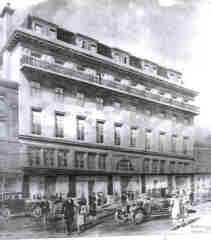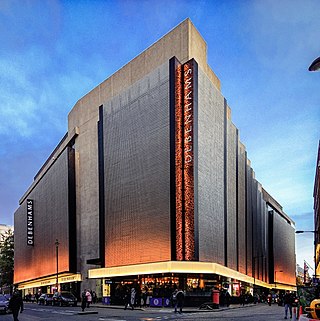
Plummer Roddis was a chain of department stores based in the South of England which was acquired by the Drapery Trust, before being absorbed by its parent company Debenhams.

Plummer Roddis was a chain of department stores based in the South of England which was acquired by the Drapery Trust, before being absorbed by its parent company Debenhams.
Plummer Roddis began as separate companies in the 19th Century. William Plummer started out as a draper in Hastings and in 1871 had a store at 3 Robertson Street [1] before opening another shop in Southampton on the corner of Above Bar and Commercial Street. [2] George Roddis was listed, in 1870, as a draper in Market Harborough. [3] By 1881 he had become a partner in Roddis & Goldsmith, drapers and milliners, at 1-2 Robertson Street, Hastings. [4]
In 1896 William Plummer, George Roddis and Reginald Tyrrell, a Bournemouth draper, joined forces to create Plummer, Roddis & Tyrrell Limited. This new business was formed to purchase the stores in which the various partners already had an interest, Plummer & Lawford of Eastbourne; [5] R. Tyrrell & Sons of Bournemouth and Boscombe [6] and Plummer, Roddis & Beecroft of Hastings and Folkestone. [7] [8] [9] Two years later, however, Reginald Tyrrell relinquished his interest in the company to concentrate on his other burgeoning business, Tyrrell & Green, in Southampton. At this point the remaining partners changed the name of the company to Plummer Roddis Limited. [10] Plummer Roddis had become a well known name along the south coast of England by the time it secured a mention in 'Kipps: The Story of a Simple Soul' by H. G. Wells in 1905. [11]
In 1914, the company reported profits of £19,208. By 1919, however, this figure had almost trebled, to £56,927, paying a dividend of 10%. [12] The business continued to expand with the purchase of Sharmans of Brighton in December 1919. [13] [14] [15]
In 1927 the flagship Hastings store was rebuilt to a design by architect Henry Ward (he also designed additions to the Brighton store), while the Southampton and Bournemouth branches were extensively rebuilt. The last building work to be completed before World War II was the extension at Bournemouth in 1938. [16] The head office of the Plummer Roddis group at this time was at Sillwood Road, Brighton.
By 1928, the business had become part of the Drapery Trust, owned by Debenhams. [17] [18] The new parent company supported the continuing development of the Plummer Roddis group with the addition of a new branch at Weymouth (formerly Robert R. Talbot) in 1928. [19] [20] [21]

During the Second World War the Southampton store was completely destroyed by German bombing. Trading continued thereafter from a scattering of temporary locations across the city until a new permanent store could eventually be completed. [22]
The acquisition of stores in new locations helped supplement trade and counter the wartime damage endured by existing parts of the business. The number of branches increased with various purchases made during the war years:
Parent company Debenhams extended the group's presence on the south coast after the war, adding a store at Southsea, in 1956. [31] [32] A further store was opened in the Essex seaside town of Southend-on-Sea after the announcement made in 1963 of a joint building development with grocers Garons and British Rail. [33] [34] [35] The completion of the new Southampton store in 1965 was followed by another substantial investment, this time at Guildford, where a new department store of 230,000 square feet was constructed alongside the River Wey. [36] The new Plummer Roddis Guildford opened in 1968. [37]
The 1970s were a period of great change for the Debenhams business as rationalisation and plans for a nationally visible brand identity across the group were implemented. The Plummer Roddis Southsea store was closed in 1970 and sold at auction. [38]
In the early 1970s the stores were rebranded, as Debenhams, except in Southampton where Edwin Jones took on the national name. In 1972 the Bournemouth store was relaunched as a Debenhams, by Terry Wogan, [39] only to be closed down a year later when Debenhams decided to rebrand the Bobby & Co. store in the town. The Boscombe branch had been closed the previous year.
The Southampton store continued to operate under the Plummers name after a management buyout, [40] but eventually closed on 14 August 1993. [41] The site has since been redeveloped as a teaching centre (known as the Sir James Matthews Building) for Solent University but this was taken over in 2022 by the University of Southampton. [42]
By 2000 only Hastings and Guildford, the first and last stores of the Plummer Roddis group to be opened respectively, continued to trade as Debenhams. Both closed in 2020.

Debenhams plc was a British department store chain operating in the United Kingdom, Denmark and the Republic of Ireland, and is still operating as a franchise in seven Middle East countries. It was founded in 1778 as a single store in London and grew to 178 locations across those countries, also owning the Danish department store chain Magasin du Nord. In its final years, its headquarters were within the premises of its flagship store in Oxford Street, London. The range of goods sold included middle-to-high-end clothing, beauty, household items, and furniture.

Allders was an independent department store operating in the United Kingdom.

Lee James Barnard is a retired English footballer who played as a striker.
Cavendish House is Cheltenham's oldest department store, located on The Promenade. Its establishment was of great significance for Cheltenham's future reputation as a leading shopping centre. Known as 'Cavendish House' from its early days, its name was officially adopted with the registration of a limited liability company in 1883. The store became part of the House of Fraser group in 1970.
Owen Owen was a Liverpool-based operator of department stores in the United Kingdom and Canada. Beginning with a drapery shop in Liverpool, a chain of department stores was built up, often by taking over rival retailers. The company remained under Owen / Norman family control until the 1980s, and the brand ceased to be used in 2007.
Tyrrell & Green was a department store located in Southampton before being rebranded as part of John Lewis Partnership.

John Lewis & Partners is a British brand of high-end department stores operating throughout the United Kingdom, with concessions also located in Ireland. The brand sells general merchandise as part of the John Lewis Partnership. It was created by Spedan Lewis, son of the founder, John Lewis, in 1929. From 1925 to 2022, the chain had a policy that it would always at least match a lower price offered by a national high street competitor; this pledge was known by the name "Never Knowingly Undersold".

Beales is an English department store chain, which currently operates 2 branches, in Poole and Southport. The former flagship store, Beales in Bournemouth, was established as The Fancy Fair by John Elmes Beale in 1881 and was the biggest department store in Dorset. The chain expanded through acquiring other department stores and continued to run two stores branded as Palmers in Great Yarmouth and Lowestoft until its closure.

Henry Ward ARIBA was a British architect who designed many large public buildings in and around Hastings, East Sussex, some of which are listed buildings.

Churchill Square is the principal shopping centre in the centre of Brighton and Hove, a city on the south coast of England. It is at the eastern end of Western Road, near the Clock Tower.
Southampton City Centre is the commercial and organisational centre of the City of Southampton, and the transport hub of the city. Because Southampton is on the South Coast of England, the city centre is not at the geometric centre of the city, but at the southern extremity.

Harefield is a suburb and Electoral Ward near Bitterne in Southampton, England. Harefield Ward consists of a small council housing estate built around 1952/3 on the 238-acre (0.96 km2) estate of Harefield House and additional private housing.
Edwin Jones was a large department store in Southampton, England founded in 1860 in East Street, Southampton with further stores established in Old Christchurch Road, Bournemouth, and Clinton Arcade, Weymouth. The business became part of the Drapery Trust, later a subsidiary of Debenhams, in 1928. The store was re-branded as Debenhams in 1973.

Gothic House is a Gothic-style building in the centre of Brighton, part of the English city of Brighton and Hove. Although it has been in commercial use for more than a century, it retains some of its original appearance as "one of the most fascinating houses" built by the prolific partnership of Amon Henry Wilds and Charles Busby. It is the only Gothic Revival building they are known to have designed: they typically adopted the Regency style, sometimes with Classical or Italianate touches. The building is Grade II listed.
Dixons was an independent department store that opened it's doors in Southend, England, during 1913 and closed for good 60 years later in 1973.
Drapery Trust formed in 1925 by Clarence Hatry, a notorious British financier. He had made his fortune in speculating on oil stocks, and had convinced investors to promote department stores and bring them under the management of a retail conglomerate. The business was acquired by Debenhams in 1927 and was run as a subsidiary until the 1970s.
Bobby & Co. was a provincial department store group based mainly in seaside towns on the south coast of England. The business operated from 1887 until 1972. During the 1920s it became part of the Drapery Trust, which in turn became a subsidiary of Debenhams.

Colson's, later Dingle's and House of Fraser, was a department store located in Exeter, Devon, England. Located on the High Street, the store was founded in 1792, then expanded after damage in the Second World War. It was later purchased and grouped with Plymouth-based Dingles, taking their name, before becoming House of Fraser. The store closed in 2019, along with a number of other House of Fraser stores during financial difficulties at the group. The site was derelict for a number of years, before being renovated during 2022 by IHG Hotels & Resorts as a Hotel Indigo, including a restaurant named "Colson's" in recognition of the history of the building.
{{cite journal}}: Cite journal requires |journal= (help){{cite journal}}: Cite journal requires |journal= (help){{cite magazine}}: Cite magazine requires |magazine= (help)